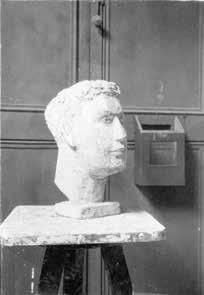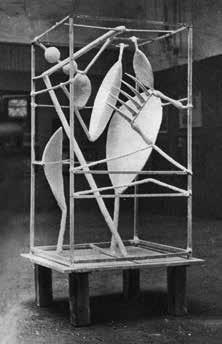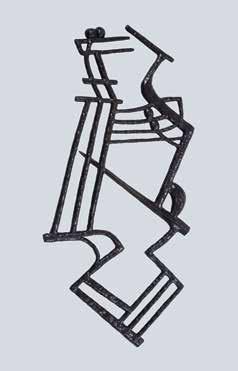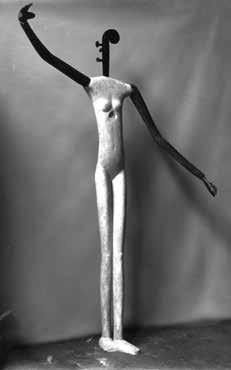
6 minute read
ALBERTO GIACOMETTI / In Search of Lost Works
"In Search of Lost Works" is an investigation on the traces of Alberto Giacometti’s works from 1920 to 1935. Disappeared? Not completely. For Alberto Giacometti left clues behind, precious documented testimonies that today allow us the opportunity to present at the Giacometti Institute littleknown works or works that has never been shown. Sold and then forgotten, lost or destroyed, these works, whose fate is often unknown, have their own story. And though almost a century separates us from young Giacometti’s years of formation and visual research, the quest for clues within the archives allows these unique creations not to be forgotten.
LES SOURCES
Advertisement

Alberto Giacometti, Sketches of Surrealist Object (1932, Partially Lost), Snake (c. 1931-1932, Lost), Little Desperate Man (1931, Lost) and Embryo (1931-1932, Lost). Pencil on sketchbook. Fondation Giacometti, Paris
Using Giacometti’s correspondence with those closest, old publications and archival photographs, the exhibition focuses on the importance of those lost works. The artist’s many sketchbooks were an invaluable source in the search for disappeared sculptures. The deciphering of notes and sketches they contain enables us not only to present works never shown, but also offers us an insight into the reflections and the creative process of the artist.
ACADÉMIE

Alberto Giacometti’s Self-Portrait (1925). Photo : anonyme, n. d. Archives de la Fondation Giacometti, Paris
From Giacometti’s years of training at the Académie de la Grande Chaumière in Paris, only one sculpture has survived. This Self-Portrait (1925) is shown here exceptionally thanks to a loan from the Alberto Giacometti-Stiftung, Zurich. Acquired very early on, between 1927 and 1930, by a Swiss artist friend, this work thus escaped destruction. Giacometti mentioned in fact that he had the sculptures from his first Parisian years taken and thrown away sometime after leaving the Académie. Three other sculpted plasters are known thanks to photographs: a female bust, a head on a base and a painted standing man. After that initial moment of doubt, Giacometti never again totally destroyed the creations of a whole period of work.
DOCUMENTARY RECONSTITUTIONS

Documentary Reconstitution after a photograph of Silence Bird (1930-1933, destroyed). Documentation de la Fondation Giacometti, Paris
Documentary reconstitutions in three dimensions, made for this exhibition from archival documents, make it possible to visualise three lost pieces that were milestones in the artist’s career: Bas-relief, created for Georges Henri Rivière in 1929, Silence Bird, exhibited at the Salon des Surindépendants in 1933 and Mannequin, shown in 1933 at Galerie Pierre Colle. They are presented alongside photographs that enabled that reconstitution, as well as the artist’s sketches and original sculptures of the same period.

Alberto Giacometti. Composition (c. 1927-1928, Lost). Photo : anonyme, n. d. Archives de la Fondation Giacometti, Paris
SILENCE BIRD

Silence Bird (1930-1933, destroyed) at the VI Salon des Surindépendants, VU No 294, 1933. Photo : anonyme, 1933. Archives de la Fondation Giacometti, Paris
Created for the 6th Salon des Surindépendants in 1933, Silence Bird is the enlarged version of Cage, made first as a plaster maquette (destroyed) before being made in wood, by a woodcarver around 1931. It reveals the temptation of the artist to project his sculptures to human scale. Several works from the same period appear in this scale in a drawing but this is the only one that he realised and showed. If Giacometti mentioned his plans to destroy “the large cage” in one of this notebooks, Silence Bird was first stored in Max Ernst’s studio, for lack of place in Giacometti’s, where it was accidentally destroyed.
BAS-RELIEF

Documentary Reconstitution After a Photograph of Bas-Relief (1929, Lost). Created for Georges Henri Rivière. Documentation de la FondationGiacometti, Paris
The year 1929 was decisive for Giacometti, who not only achieved his first success on the Parisian art scene, but accepted equally a commission from Georges Henri Rivière, co-founder of the publication Documents, and assistant director to the Musée d’ethnographie du Trocadéro in Paris. For the apartment of Rivière and his spouse, Giacometti proposed a bas-relief that took up the symbolics appreciated by the surrealists, the art movement that he joined in 1930. He chose to represent a sexual act, in which human bodies are simplified to abstraction. That bas-relief in bronze was unfortunately lost following the divorce of the Rivière couple, and the liquidation of their apartment a few years later.
MANNEQUIN

Mannequin (1932-1933, lost). Photo : Marc Vaux, n. d. Archives de la Fondation Giacometti, Paris
A stylised female body, Mannequin (1932-1933) is one of the variations on the famous surrealist piece Walking Woman (1932-1936), a slender figure without head and arms inspired by Egyptian art. Mannequin took its inspiration more directly from the mannequins in shop windows of which the surrealists were very fond. In this version, the sculpture is provided with a head made with the neck of a violin, its long arms ending in a flower or feathers. In 1933, it was presented at the Exposition surréaliste at Galerie Pierre Colle. Giacometti simplified it after, removing the elements that appeared unnecessary (the head and the arms) and added to it a small pedestal to stabilise and make it a sculpture.
CUBISM AND COMPOSITIONS

Alberto Giacometti, Cubist Figure I. Plaster. Fondation Giacometti, Paris
In the middle of the 1920s, Giacometti distanced himself from formal visual language and turned to a simplification of forms taken to thelimits of abstraction. The artist remained attached to therepresentation of the human being, a main preoccupation throughout hislife. Though there are several accounts on the sculptures he made at thetime, which were exhibited in the Art Salons and galleries in Paris,very few works from that period have been preserved to this day. Toodelicate or sold by a still little-known artist, a large number of thosepieces have disappeared.
FONDATION GIACOMETTI, PARIS
Direction : Catherine Grenier, Directrice de la Fondation Giacometti, Présidente de l’Institut Giacometti ; Sabine Longin, Secrétaire générale ; Céline Suer, Assistante de direction.
Institut Giacometti : Christian Alandete, Directeur artistique ; Stéphanie Barbé-Sicouri, Responsable des affaires administratives et des opérations ; Hugo Daniel, Responsable de l’École des Modernités, Chargé de mission curatoriale ; Alice Martel, Chargée des publics et de la médiation.
Collection, recherche et expositions : Émilie Bouvard, Directrice des collections ; Serena Bucalo-Mussely, Conservatrice ; Thierry Pautot, Responsable des archives et de la recherche, Attaché de conservation ; Michèle Kieffer, Responsable du Comité Giacometti, Attachée de conservation ; Romain Perrin, Attaché de conservation.
Régie des collections et des expositions : Alban Chaine, Chargé des collections, Responsable de la Régie ; Clara Gibertoni, Régisseuse.
Coordination des expositions et des éditions : Philippe de Saint Martin Beyrie, Chargé de coordination des expositions, Chargé des éditions.
Affaires juridiques : Émilie Le Mappian, Responsable.
Affaires administratives et comptables : Doriane Denis, Chargée de mission.
Communication : Simon Hübe, Responsable marketing et communication ; Anne-Marie Pereira, Chargée des relations presse.
Assistants : Manon Rebuffel, Mathilde Renouart, Matheus Van Ngoc, Abigail Holstein.
Mécènes de l’institut Giacometti
Emerige
LVMH
Mécènes individuels : Cercle des membres fondateurs
ALBERTO GIACOMETTI / In Search of Lost Works
Exposition
Commissaire : Michèle Kieffer. Production : Stéphanie Barbé-Sicouri. Régie des œuvres : Clara Gibertoni, Stéphanie Barbé-Sicouri. Scénographie : Eric Morin. Lumières : ACL, Transpalux. Agencement : Jet Lag K. Encadrement : Cadre en Seine, Laurent Blaise Saint Maurice. Signalétique : Œil de Lynx. Programme pédagogique : Alice Martel. Médiation : Manon Delarue, Sahra Sebbahi, Théodore Parizet, Laura Partin.
Livret
Conception graphique : Brigitte Mestrot. Traduction : Catherine Petit & Paul Buck. Impression : Stipa, Montreuil.
Crédits
Pour les œuvres d’Alberto Giacometti © Succession Alberto Giacometti (Fondation Giacometti, Paris + Adagp, Paris) 2020
Couverture : Alberto Giacometti and Small Man (1926-1927, destroyed). Photo : anonyme, n. d. Archives de la Fondation Giacometti, Paris
#GiacomettiLostWorks
PAUL FOLLOT' MANSION

The Giacometti Institute is established in the former studio of the interior designer Paul Follot (1877-1941). Characterised by a style that evolved from the aesthetics of Art Nouveau to the geometrization of forms of Art Déco, Follot was one of the founding members of the Société des artistes décorateurs, before managing, from 1923 onwards, the design workshop of the department store Le Bon Marché. This town-house, of which he was the architect, comprised his studio, his presentation rooms and his living accommodations. The architecture and decor show the influence of Viennese modernism. All the remaining furniture and decor, listed in the inventory of historical buildings, has been restored by the architect Pierre-Antoine Gatier at the time of the establishment of the Giacometti Institute. The contemporary arrangements were made by the architect Pascal Grasso.


